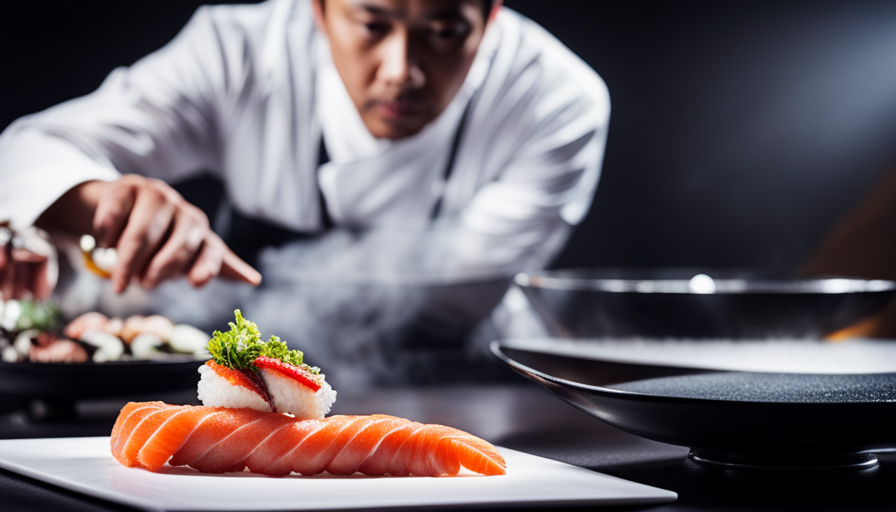Have you ever felt drawn to the appeal of fresh, raw fish? The idea of enjoying delicate slices of sashimi or a zesty ceviche can be very tempting. Nevertheless, the concern of food poisoning might prevent you from fully experiencing this culinary journey.
But fear not! I’m here to guide you on how to enjoy raw fish without the worry of a stomach-churning aftermath. Just like a skilled fisherman casting his net, there are precautions you can take to ensure your safety.
By choosing the freshest and highest-quality fish from reputable sources, freezing it before consumption, and employing proper handling and storage techniques, you can greatly reduce the risk of foodborne illnesses. Additionally, being mindful of cross-contamination, dining at well-regulated restaurants, and paying attention to your body’s signals can further safeguard your health.
And if, despite your best efforts, you do fall ill, don’t hesitate to consult a doctor for guidance. So, cast aside your concerns and embark on a gastronomic journey with confidence, savoring the deliciousness of raw fish without the fear of food poisoning.
Key Takeaways
- Choose fresh and high-quality fish: Look for clear eyes, shiny flesh, and a mild oceanic scent to ensure freshness.
- Buy from reputable sources: Look for strict quality control measures, transparency and traceability, and regular inspections to ensure the fish is safe to consume.
- Freeze the fish before consumption: Freezing the fish kills potential parasites and helps preserve its quality.
- Practice proper handling and storage techniques: Wash hands thoroughly, use separate cutting boards and utensils, store in a sealed container below 40°F (4°C), and consume within a day or two of purchase to prevent cross-contamination and maintain freshness.
Choose Fresh and High-Quality Fish
To enjoy the tantalizing taste of raw fish without any worries, you’ll want to make sure you choose the freshest and highest quality fish available. Proper fish selection is crucial for ensuring sushi safety and minimizing the risk of food poisoning.
When it comes to raw fish, freshness is key. Look for clear and vibrant eyes, shiny and firm flesh, and a mild oceanic scent. Avoid fish with cloudy eyes, dull flesh, or a strong fishy smell, as these are indications of poor quality or improper storage.
It’s also important to buy from reputable and trusted sources. These establishments have stringent quality control measures in place to ensure the fish is handled and stored properly. They have dedicated seafood departments that follow strict guidelines for fish selection and storage, minimizing the risk of contamination.
By choosing fresh and high-quality fish from reputable sources, you can savor the delectable flavors of raw fish without the fear of food poisoning.
Buy from Reputable and Trusted Sources
When it comes to consuming raw fish, make sure to purchase it from well-known and reliable sources to ensure you don’t end up with a stomachache that feels like a million fiery needles poking at your insides. Buying locally sourced fish is a great way to support your community and ensure freshness.
Local fish markets often have a direct relationship with fishermen, allowing you to trace the fish back to its source. This transparency can give you peace of mind knowing that the fish was handled properly from the moment it was caught.
Understanding fish sourcing is crucial in avoiding food poisoning. Reputable sources prioritize sustainable fishing practices and adhere to strict regulations. They often conduct regular inspections, ensuring that the fish is handled and stored correctly to maintain its quality. Additionally, these sources have systems in place to quickly identify and recall any contaminated products.
By purchasing from reputable and trusted sources, you can minimize the risk of food poisoning and enjoy raw fish safely. However, it’s important to note that even the best sources can have occasional mishaps. To further ensure the safety of your raw fish consumption, it’s recommended to freeze the fish before consumption. This additional step will help eliminate any potential parasites or harmful bacteria that may be present.
Freeze the Fish Before Consumption
By freezing your fish before enjoying it, you can take an extra precautionary step to ensure the safety and quality of your raw seafood experience. Fish freezing is a common practice in the culinary world, especially when it comes to consuming raw fish.
Freezing fish at temperatures below -4°F (-20°C) for at least seven days can kill any potential parasites that may be present in the fish. This process is known as freezing to kill parasites (FTP) and is recommended by health organizations to reduce the risk of foodborne illnesses.
The benefits of freezing fish go beyond eliminating parasites. It also helps to preserve the quality of the fish. Freezing slows down the growth of bacteria, preventing spoilage and maintaining freshness. Additionally, freezing can improve the texture of certain types of fish, making them firmer and easier to slice for sashimi or sushi.
However, it’s important to note that not all fish are suitable for freezing. Some delicate fish, such as tuna or salmon, freeze well and retain their quality. On the other hand, fish with a higher water content, like mackerel or herring, may not freeze as successfully. It’s crucial to choose fish that’s fresh and of high quality before freezing.
By freezing your fish, you can ensure that it’s safe to consume raw. However, it’s equally important to use proper handling and storage techniques to maintain its safety and quality.
Use Proper Handling and Storage Techniques
Ensure the safety and quality of your raw seafood experience by properly handling and storing your fish. When it comes to raw fish, proper handling techniques are crucial to prevent foodborne illnesses. Always wash your hands thoroughly before and after handling raw fish to avoid cross-contamination. Use separate cutting boards and utensils for raw fish to prevent the spread of bacteria. Additionally, make sure to clean and sanitize all surfaces that come into contact with the raw fish.
Proper storage techniques are equally important. Raw fish should be stored in a refrigerator at a temperature below 40°F (4°C) to slow down the growth of bacteria. It’s recommended to keep the fish in a sealed container or wrap it tightly in plastic wrap to prevent any leakage or odors from spreading to other foods. It’s also essential to consume the fish within a day or two of purchase to ensure freshness and minimize the risk of food poisoning.
By following these proper handling and storage techniques, you can enjoy the goodness of raw fish without compromising your health.
Next, let’s move on to preparing the fish properly, ensuring a delicious and safe dining experience.
Prepare the Fish Properly
Now that we’ve covered the importance of proper handling and storage, let’s dive into the art of preparing the fish to enhance its flavors and create a memorable dining experience. When it comes to raw fish, fish preparation techniques and cooking methods play a crucial role in ensuring its safety and palatability.
To prepare raw fish safely, follow these essential steps:
- Start by selecting the freshest fish possible. Look for clear eyes, shiny skin, and a mild oceanic smell.
- Use a sharp knife to fillet the fish, removing any bones or skin. This will ensure a smooth and enjoyable eating experience.
- Cut the fish into thin slices, taking care to maintain a consistent thickness. This allows for even marination and proper cooking.
- Marinate the fish in a mixture of soy sauce, citrus juice, and seasonings. This not only adds flavor but also helps to kill any potential parasites or bacteria.
- Finally, serve the raw fish immediately or refrigerate it at a very cold temperature until ready to serve.
By following these fish preparation techniques and cooking methods, you can enjoy raw fish without the risk of food poisoning. Now let’s transition into the next section, where we’ll discuss the importance of paying attention to hygiene and cleanliness to further ensure food safety.
Pay Attention to Hygiene and Cleanliness
Take a moment to consider the importance of maintaining proper hygiene and cleanliness when handling and preparing your fish. One of the key aspects of this is ensuring that you practice proper handwashing techniques. Washing your hands thoroughly with soap and warm water for at least 20 seconds before and after handling raw fish is crucial in preventing the spread of harmful bacteria. This simple step can significantly reduce the risk of food poisoning.
In addition to handwashing, the role of clean utensils cannot be overstated when it comes to preventing food poisoning. Using clean knives, cutting boards, and other utensils when handling raw fish helps to avoid cross-contamination. Any residue or bacteria left on these tools can easily transfer to the fish and contaminate it, leading to potential illness. Therefore, it’s essential to wash utensils with hot, soapy water after each use and sanitize them regularly.
By paying attention to hygiene and cleanliness, such as proper handwashing and using clean utensils, you can significantly reduce the risk of food poisoning when eating raw fish. However, it’s important to be mindful of cross-contamination, which we’ll delve into in the next section. Transitioning into the subsequent section, it’s crucial to understand how to prevent the spread of bacteria from one surface to another.
Be Mindful of Cross-Contamination
Be cautious of cross-contamination to avoid spreading harmful bacteria from one surface to another while handling and preparing your fish. Cross-contamination occurs when bacteria from one food source, such as raw fish, comes into contact with another surface or food item, leading to potential foodborne illness.
To prevent cross-contamination, it’s essential to wash your hands properly before and after handling raw fish. Use warm water and soap, scrubbing your hands for at least 20 seconds to remove any potential bacteria.
Additionally, make sure to clean and sanitize all utensils, cutting boards, and countertops that come into contact with raw fish.
Preventing cross-contamination also involves keeping raw fish separate from other ingredients. Use separate cutting boards and utensils for fish and other food items to avoid any potential transfer of bacteria.
It’s also crucial to store raw fish in sealed containers or bags to prevent any leakage or contact with other foods in the refrigerator.
By following these simple steps, you can minimize the risk of cross-contamination and ensure the safety of your raw fish consumption.
Transitioning into the subsequent section about eating at reliable and well-regulated restaurants, it’s important to note that while practicing proper hygiene and cleanliness at home is crucial, eating raw fish at reputable establishments can provide an added layer of assurance.
Eat at Reliable and Well-Regulated Restaurants
Choose a reputable restaurant that follows strict regulations and enjoy the peace of mind that comes with knowing your meal is prepared safely. When it comes to eating raw fish without getting food poisoning, one of the most important factors is the reliability and regulation of the restaurant you choose.
Before dining at any establishment, it’s crucial to check restaurant reviews to ensure that others have had positive experiences with their raw fish dishes. Look for reviews that mention the freshness and quality of the fish, as well as any comments about food safety and cleanliness.
Government regulations also play a vital role in ensuring food safety at restaurants. Reliable and well-regulated establishments adhere to strict guidelines set by the government to prevent foodborne illnesses. These regulations involve regular inspections, proper handling and storage of raw fish, and strict hygiene practices. By eating at a restaurant that follows these regulations, you can significantly reduce the risk of food poisoning from raw fish.
Transitioning into the next section, it’s important to listen to your body and watch for any symptoms. While choosing a reputable restaurant is a crucial step in preventing food poisoning, it’s also essential to be aware of your own body’s reactions. By paying attention to any unusual symptoms, such as nausea, vomiting, or diarrhea, you can quickly identify if something is wrong.
Listen to Your Body and Watch for Any Symptoms
Pay attention to any unusual symptoms that may arise after consuming raw fish, as studies have shown that approximately 20% of individuals experience gastrointestinal issues within 24 hours of ingestion. It is important to watch for symptoms and trust your instincts when it comes to your health. Here are some key things to keep in mind:
- Nausea: Feeling queasy or experiencing an upset stomach after eating raw fish may indicate food poisoning.
- Diarrhea: Frequent loose or watery stools can be a sign that your body is reacting negatively to the raw fish.
- Vomiting: If you find yourself throwing up after consuming raw fish, it’s essential to take this symptom seriously.
- Abdominal Pain: Persistent pain in your abdomen, especially if it’s severe or accompanied by other symptoms, should not be ignored.
- Fever: An elevated body temperature after eating raw fish may indicate an infection or foodborne illness.
If you experience any of these symptoms, it’s crucial to consult a doctor. They can help determine the cause of your illness and provide appropriate treatment. Remember to take any signs of illness seriously and seek medical attention if needed.
Consult a Doctor if You Experience Any Illness
If any symptoms arise, it is advisable to consult a doctor to address any potential illnesses. When it comes to consuming raw fish, it is important to be cautious and aware of any changes in your body. While raw fish can be delicious and nutritious, it also carries a risk of food poisoning due to the presence of harmful bacteria or parasites.
Consulting professionals and seeking medical advice is crucial if you experience any illness after eating raw fish. A doctor can perform the necessary tests and examinations to determine the cause of your symptoms and provide appropriate treatment. They may ask about your symptoms, conduct a physical examination, and order laboratory tests to identify any bacterial or parasitic infections.
To emphasize the importance of seeking medical advice, consider the following table:
| Symptoms | Possible Causes | Recommended Action |
|---|---|---|
| Nausea | Bacterial | Consult a doctor |
| Vomiting | Parasitic | Seek medical advice |
| Diarrhea | Infection | Contact healthcare |
| Abdominal pain | Food poisoning | Seek professional help |
| Fever | Bacterial | Consult a healthcare professional |
Remember, it is always better to be safe than sorry. Don’t hesitate to consult a healthcare professional if you experience any adverse effects after consuming raw fish. They are trained to diagnose and treat food-related illnesses and can provide the necessary guidance to ensure your well-being.
Frequently Asked Questions
Can I eat raw fish that has been frozen for a long time?
Yes, you can eat raw fish that has been frozen for a long time. Freezing fish kills parasites and bacteria, making it safe for consumption. However, it’s important to ensure that the fish has been properly frozen and stored at a consistently low temperature. Thaw it in the refrigerator and use it within 24 hours. Remember, freezing doesn’t guarantee freshness, so check for any signs of spoilage before eating. Is it safe? Absolutely, if you follow these guidelines.
How can I tell if the fish I’m buying is fresh and of high quality?
To ensure that the fish I’m buying is fresh and of high quality, there are a few key things I look for. Firstly, I check for clear, bright eyes and shiny, moist skin. The fish should also have a mild, oceanic smell. Additionally, the flesh should be firm and spring back when pressed.
To maintain freshness, I store raw fish in the refrigerator at a temperature below 40°F and use it within 1-2 days. I also make sure to identify any signs of spoilage, such as a strong, unpleasant odor or slimy texture.
Is it safe to eat raw fish if I have a compromised immune system?
As someone with a compromised immune system, I understand the concern about eating raw fish. While it’s generally safe for most people, precautions should be taken during chemotherapy.
It’s crucial to ensure the fish is fresh and of high quality. Additionally, it’s recommended to only consume fish that’s been previously frozen, as freezing kills many parasites and bacteria.
Consulting with a healthcare professional is essential to make informed decisions about raw fish consumption.
Can I eat raw fish if I am pregnant or breastfeeding?
During pregnancy, it’s recommended to avoid consuming raw fish due to the risk of foodborne illnesses. However, if you’re breastfeeding, you can enjoy the benefits of eating raw fish in moderation. It’s important to take certain precautions, such as ensuring the fish is fresh, properly sourced, and stored at the correct temperature. Additionally, it’s advisable to consult with your healthcare provider to ensure the safety and suitability of consuming raw fish while breastfeeding.
Are there any specific types of raw fish that are more likely to cause food poisoning?
When it comes to raw fish, not all types are created equal in terms of food poisoning risk. Some fish, like tuna and salmon, are more likely to cause food poisoning due to their higher levels of bacteria and parasites.
However, by taking certain precautions, such as ensuring the fish is fresh, properly stored, and sourced from reputable suppliers, you can significantly reduce the risk. Additionally, being aware of specific signs of food poisoning, such as nausea, vomiting, and diarrhea, can help you seek medical attention promptly if needed.
Can the same methods used to fight off food poisoning from raw oysters be applied to eating raw fish without getting food poisoning?
Yes, the same methods for fighting food poisoning from raw oysters can be applied to eating raw fish. Both should be sourced from reputable suppliers, stored at safe temperatures, and consumed soon after purchase to reduce the risk of food poisoning. Additionally, practicing good hygiene when handling raw seafood is crucial.
Conclusion
Well, folks, it seems like we’ve reached the end of our journey on how to enjoy raw fish without the dreaded food poisoning. I must say, it’s been quite the adventure navigating the treacherous seas of sushi consumption. But fear not, for armed with the knowledge of choosing fresh fish, freezing it, and handling it properly, you can now indulge in this risky delicacy without a care in the world.
Just remember, if all else fails, consult a doctor and hope for the best. Happy eating!










